The Sea Cadets is a youth organization that provides fun, social and educational experiences to girls and boys aged 12 to 18. Sea cadets participate in a variety of training, and can get coaching in nautical activities like sailing, power boat operation, and on-the-water communications as well as improving their level of fitness. Also, cadets have the chance to participate in other activities related to the military, including precision drill, music, and marksmanship. Every local sea cadet corps has a special name, usually named after a ship, or an important person. The Victoria-based group is named after HMCS Rainbow.
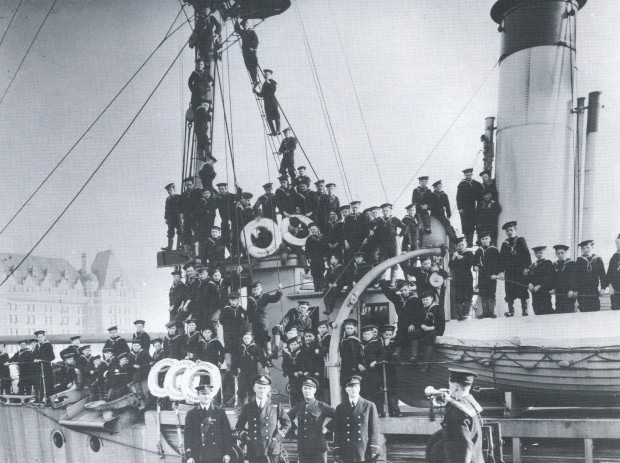
The turn of the century was an exciting and innovative time for young men and boys on the West Coast. Canada was a fledgling nation and the birth of a new century would lead an en entire country to thoughts of independence from the formidable British Empire. Being a maritime nation many young men’s dreams took to the sea. One of the most influential groups in support of the development of our own maritime defense force was the Navy League. Patterned on the British organization, one of the founding branches was formed here in Victoria in 1896. The Navy league had both naval and maritime interests. It was with these interests in mind that they became involved in youth training with the formation of Boys’ Naval Brigade’s, the forerunner to sea cadets.
The boys’ Naval Brigade began in Victoria in February of 1918. A small group of boys met at the Menzies Street Drill hall under the direction of Captain Jones-Evans, a retired merchant Navy captain from the White Star Line. The group would not receive official recognition until March 16, 1918 when along with about twenty other branches they received letters of patent from the Navy League of Canada.
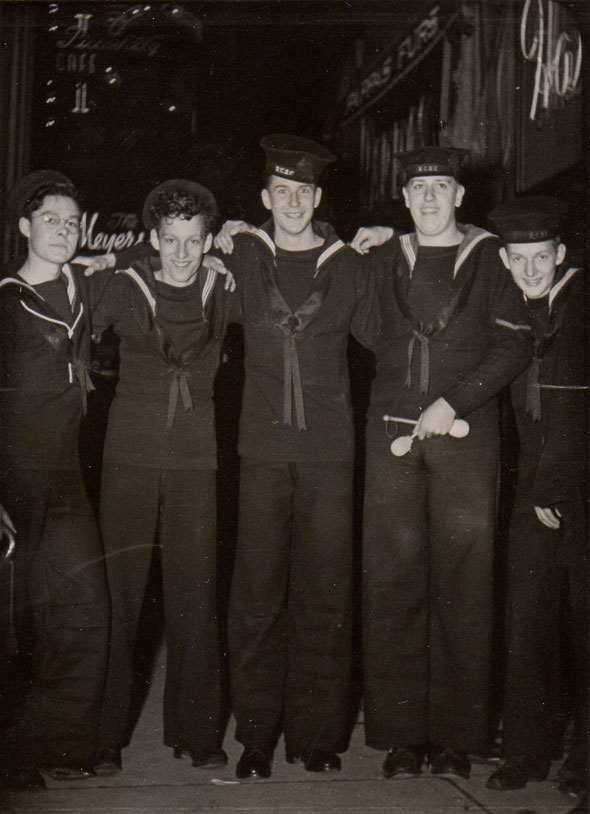
In the period between WWI and WWII, the average range of the boys who joined was between eleven and sixteen. They paid a small fee to join and were given a uniform and told to report for parades. In the early years, the boys met in a variety of locations including the basement of the Pemberton building, but they usually made their home at the Menzies drill hall. From the beginning, the group had little money, for though the Navy League was an influential organization, they certainly were not wealthy. Uniforms, instructors and space were all scrounged. Despite this the Navy League had high hopes for these young cadets, hopes that they had no problem fulfilling.
The year 1920 would prove to be a turning point for the boys as this was the year that Lieutenant-Commander Percival William Tribe took over command. “Pop” Tribe as he was affectionately known as was to devote twenty-six years of his life to Rainbow Sea Cadets. Little is known about “Pop” Tribe’s personal life other than that he served in the Royal Navy and that he operated a small dairy farm near Victoria. He is remembered as a gentle, unassuming man who was devoted to his cadets.
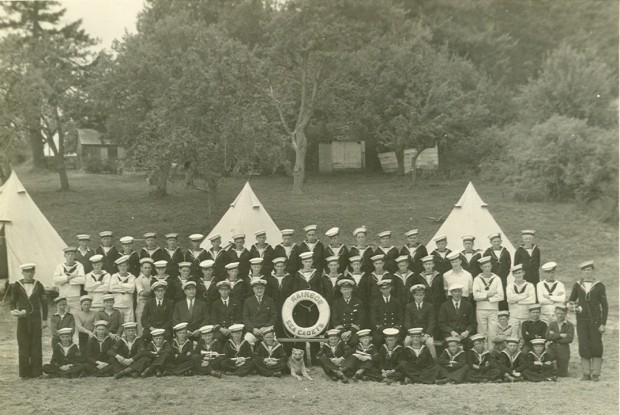
The 1930s were trying years for Rainbow. Times were hard for everyone; men were without work and people made do with what they had. The cadets found it difficult to find support in an increasingly pacifist world. They were forced to move the location of their cadet corps once again from the Menzies Street Drill Hall. However, through the generosity of Mr. Rithet, a prominent Victoria business man, they found a home in an unused shed at the outer wharf leading to Victoria Harbour. Little by little they equipped the building and things became shipshape. Despite the pacifist era the world was going through people began to realize what excellent training was offered to these cadets. The ranks of the Rainbow swelled to over 100 cadets.
With the outbreak of World War II in 1939, the cadets were forced to move again. Victoria Machine Depot took over Rithet’s pier and the cadets found refuge at Craigflower School. Though they were lucky to have accommodation, a more permanent home was necessary. The Navy League negotiated with the James Bay Athletic Association and Rainbow moved to an ideal location, the former James Bay Athletic Club on Robert Street in Esquimalt. Covering six city lots, there was more than enough room for everything the cadets would require. Soon after their move the cadets set to work. It took several years but the results were a parade square, boathouse, wharves and a rifle range.
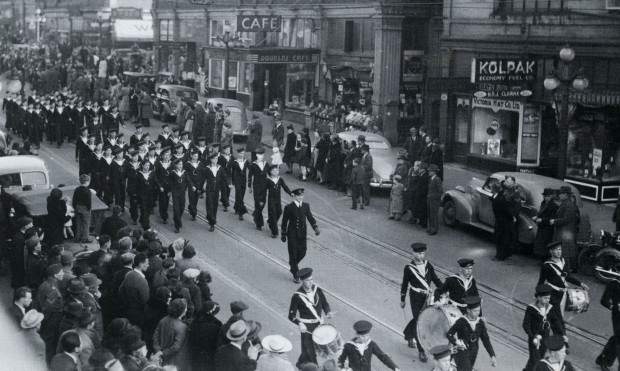
The 1940s held major changes for the cadet movement. The navy saw the advantages of the training offered by Sea Cadets in assisting with the war effort. They agreed to sponsor the organization in partnership with the Navy League and in 1943 Sea Cadets had the prefix “Royal” added to their name. During this time cadets and the Rainbow corps especially, were in their heyday. The cadet movement gave young men the opportunity to feel they were making a contribution to a war they were not old enough to fight. Rainbow had its largest enrollment during this period with almost 400 cadets.
As the patriotic fervor brought on by the Second World War faded, the 1950s saw a gradual decline in enrollment in the cadet corps. Rainbows enrollment, however, remained relatively high. This was due not only to the support of the RCN and the excellent training program but primarily to the officers and instructors tasked with leading the organization. LCdr Dando assumed command in 1950 and the length of his tenure was second only to that of LCdr Tribe. The cadets were settled at the Robert Street Barracks and improvements and upgrades were slowly made.
Unfortunately, there was a black cloud on the horizon. Financial troubles were beginning to plague the Navy League and would continue to do so for many years. The money required to maintain the barracks and the property taxes was considerable. Fundraising events provided much of the necessary cash but could not guarantee a constant source of revenue. These difficulties would eventually lead to the sale of the Robert Street Barracks.
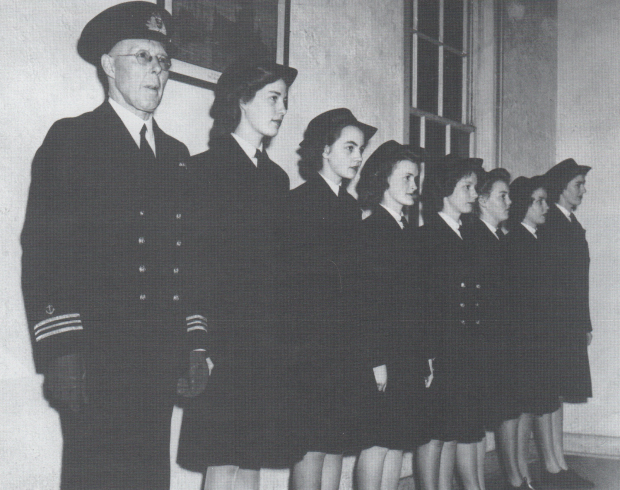
A little known piece of Rainbow history is that the corps lay claim to the first wrenettes. The female members of the corps came to be known as wrenettes, taken from the slang “Wren” which was used to describe women in the RCN. Though never officially sanctioned or recognized by the Navy League, they did exist. Mr. Harold Page, the Regulation Petty Officer at the time, realized if there were females in the Regulating office to do the paper work it would free up the male cadets for other training. A close friend, Gladys Baxter (the future Mrs Page), secretarial student at Mount View High School approached LCdr Tribe. Though hesitant at first, he agreed and it was not long before Gladys and her six of her friends were busy in the Ship’s office. Initially the wrenettes duties were administrative, but that began to change in April of 1963 when the Pat Dufour Navy League Wrenette Corps was given its official charter. The corps was named in honour of Pat Dufour, the woman who did so much to support the organization and further the goals of these groups.
Several interesting events took place over the next decade and Rainbow had a small part to play in them all. In 1953, the coronation of Queen Elisabeth II in Victoria took place, with Rainbow cadets present. In 1958, the city of Victoria celebrated its Centennial. To commemorate the event, the cadets performed several Sunset Ceremonies on the Legislative Lawns. Another special event for the Rainbow was the presentation of the Ceremonial Drums by Lieutenant Governor Ross in 1960. The drums were specially made in Scotland and were presented to the corps at a ceremony at Government House.
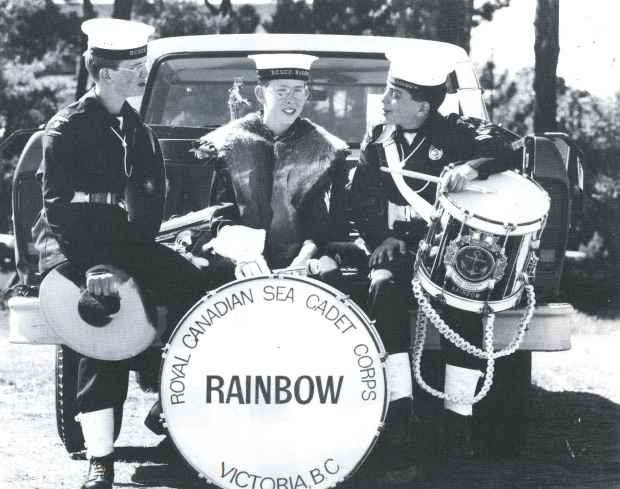
The 1970s would give rise to the most radical changes in the cadet movement due to the integration of the Canadian Armed Forces. Females were accepted as full-fledged sea cadets and Rainbow acquired new quarters. These major changes were grudgingly accepted, but despite the opposition, the officers and cadets managed to maintain the high standards that had become synonymous with Rainbow.
Financial troubles of the Navy League were gradually mounting. Fundraising events were held, the most successful of which being a “jog and walkathon” held by the cadets which raised $8,000. Unfortunately, these efforts alone would not provide the financial security they felt necessary. In 1974, after negotiating with developers and the city, the Robert Street Barracks was bought by the city and a new home was found for Rainbow at Macaulay Point. The Corps settled into Maculay Point and the Navy League’s finances were healthy. As a result, a decision was made to renovate one of the buildings on the property to provide the corps with up to date facilities. The newly renovated building, known as the Rainbow Barracks, provided everything the cadets needed. It was officially opened by Rear Admiral Edwards in 1983.
Enrollment in cadet corps in all elements declined in the early 1980s due to the rise of anti-military sentiments in the world in general. Despite competition from two other area corps Rainbow gradually increased its enrollment over these years. In 1995, the Navy League of Canada celebrated its 100th Anniversary. The League promotes the same subjects today, as at its founding: knowledge of, and support for, maritime interests. On a national level, the League supports the International Exchange Program, certain scholarships, and the National Sea Cadet Regatta, while local branches provide vital logistical support to individual RCSC Corps.
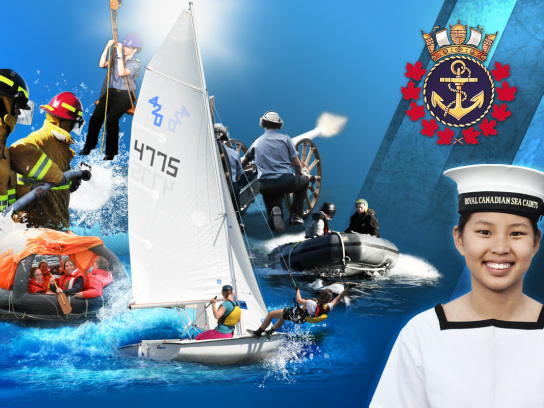
More than 95 years have gone by and many young men and women have passed through RCSCC Rainbow. Times have changed and with them some of the approaches to youth training. Through the years Rainbow has constantly produced young people who demonstrate leadership and citizenship qualities second to none. Over the years, the corps has touched many different individuals and groups in a variety of circumstances. Both the cadets and these people have been enriched by the experience and it is only through the support of these individuals and groups that the corps will continue to be the outstanding organization it is.
For more information on the Rainbow Sea Cadets click here
For information on how to join click here
Coloured images courtesy: www.victoriaseacadets.com Other images courtesy: RCSCC Rainbow: A Pictorial History 1918-1993
A special thanks to Cd. James Webb from the Victoria Sea Cadets for his help with the project.

